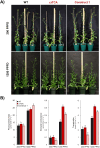In vitro demonstration and in planta characterization of a condensed, reverse TCA (crTCA) cycle
- PMID: 40551776
- PMCID: PMC12183294
- DOI: 10.3389/fpls.2025.1556957
In vitro demonstration and in planta characterization of a condensed, reverse TCA (crTCA) cycle
Abstract
Introduction: Plants employ the Calvin-Benson cycle (CBC) to fix atmospheric CO2 for the production of biomass. The flux of carbon through the CBC is limited by the activity and selectivity of Ribulose-1,5-Bisphosphate Carboxylase/Oxygenase (RuBisCO). Alternative CO2 fixation pathways that do not use RuBisCO to fix CO2 have evolved in some anaerobic, autotrophic microorganisms.
Methods: Rather than modifying existing routes of carbon metabolism in plants, we have developed a synthetic carbon fixation cycle that does not exist in nature but is inspired by metabolisms of bacterial autotrophs. In this work, we build and characterize a condensed, reverse tricarboxylic acid (crTCA) cycle in vitro and in planta.
Results: We demonstrate that a simple, synthetic cycle can be used to fix carbon in vitro under aerobic and mesophilic conditions and that these enzymes retain activity whenexpressed transiently in planta. We then evaluate stable transgenic lines of Camelina sativa that have both phenotypic and physiologic changes. Transgenic C. sativa are shorter than controls with increased rates of photosynthetic CO2 assimilation and changes in photorespiratory metabolism.
Discussion: This first iteration of a build-test-learn phase of the crTCA cycle provides promising evidence that this pathway can be used to increase photosynthetic capacity in plants.
Keywords: CO2 fixation; Camelina sativa; carbon capture; photosynthesis; reverse TCA cycle; synthetic biology.
Copyright © 2025 Wilson, Smith-Moore, Xu, Edwards, La Hovary, Li, Aslett, Ji, Lin, Vintila, Kleiner, Xie, Shachar-Hill, Grunden and Sederoff.
Conflict of interest statement
The authors declare that the research was conducted in the absence of any commercial or financial relationships that could be construed as a potential conflict of interest. The author(s) declared that they were an editorial board member of Frontiers, at the time of submission. This had no impact on the peer review process and the final decision.
Figures






Similar articles
-
Chemoautotrophy in subzero environments and the potential for cold-adapted Rubisco.Appl Environ Microbiol. 2025 Jun 18;91(6):e0060425. doi: 10.1128/aem.00604-25. Epub 2025 May 30. Appl Environ Microbiol. 2025. PMID: 40444981 Free PMC article.
-
EORTC guidelines for the use of erythropoietic proteins in anaemic patients with cancer: 2006 update.Eur J Cancer. 2007 Jan;43(2):258-70. doi: 10.1016/j.ejca.2006.10.014. Epub 2006 Dec 19. Eur J Cancer. 2007. PMID: 17182241
-
Behavioral interventions to reduce risk for sexual transmission of HIV among men who have sex with men.Cochrane Database Syst Rev. 2008 Jul 16;(3):CD001230. doi: 10.1002/14651858.CD001230.pub2. Cochrane Database Syst Rev. 2008. PMID: 18646068
-
Comparison of cellulose, modified cellulose and synthetic membranes in the haemodialysis of patients with end-stage renal disease.Cochrane Database Syst Rev. 2001;(3):CD003234. doi: 10.1002/14651858.CD003234. Cochrane Database Syst Rev. 2001. Update in: Cochrane Database Syst Rev. 2005 Jul 20;(3):CD003234. doi: 10.1002/14651858.CD003234.pub2. PMID: 11687058 Updated.
-
A rapid and systematic review of the clinical effectiveness and cost-effectiveness of paclitaxel, docetaxel, gemcitabine and vinorelbine in non-small-cell lung cancer.Health Technol Assess. 2001;5(32):1-195. doi: 10.3310/hta5320. Health Technol Assess. 2001. PMID: 12065068
References
LinkOut - more resources
Full Text Sources

